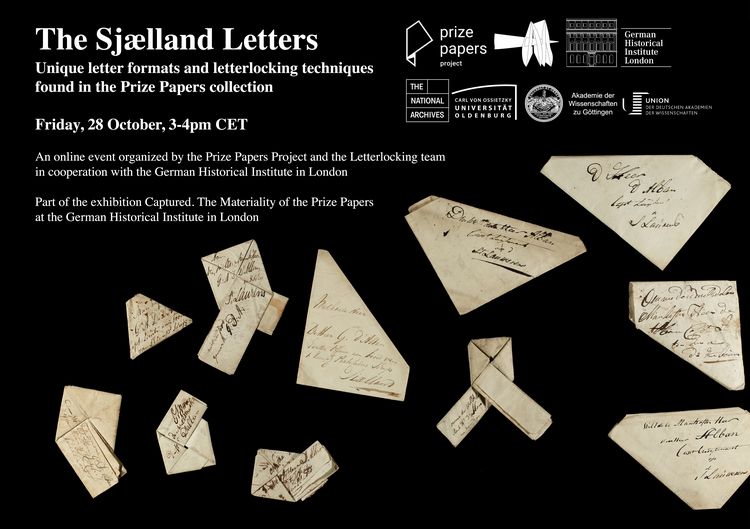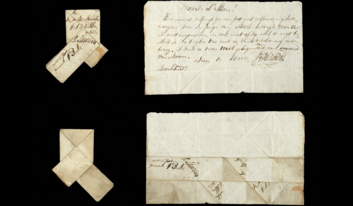The Sjælland Letters - Prize Papers Letterlocking World Premiere
The Sjælland Letters - Prize Papers Letterlocking World Premiere

The Sjælland Letters: Unique letter formats and letterlocking techniques found in the Prize Papers collection. An online event organized by the Prize Papers Project and the Letterlocking team in cooperation with the German Historical Institute London.
The Prize Papers are records and objects that were confiscated by British privateers and naval vessels between 1652 and 1815 – a period of time in which the seizure of ships was still a legitimate form of tactical warfare. The Prize Papers collection at The National Archives, UK still holds thousands of documents and various objects that have not been seen or touched for centuries. As a result, the records and artefacts belonging to the High Court of Admiralty’s collections HCA 30 and HCA 32 have survived in a condition rarely found in archives across the globe, with many records preserved exactly as they were archived during the early modern period.
One of the collection’s highlights are 160,000 intercepted letters. The lion’s share of these letters has been opened. However, several hundred have survived in their original closed or folded state until this day. As a result, hundreds of different forms, formats, folds and letter locks used for early modern letters have survived. In the Prize Papers Project, we preserve these historical folding and letterlocking techniques and document them in pictures, either as materiality shots or videos.
During the early modern period, letter writers used various forms of folding and locking of their letters for postal dispatches. Before envelopes were invented, people used letter paper to fold and lock their letters and make items sendable. Due to the unique material state of preservation of the Prize Papers collection, the original forms have been preserved and reveal the most fascinating letter formats, letter folding and letterlocking techniques of the early modern period.
Thanks to long-standing collaboration between the Prize Papers Project and the Letterlocking team (Jana Dambrogio and Daniel Starza Smith) and the team at Unlocking History, we can draw on extensive expertise in letterlocking techniques. As their pioneer research has convincingly shown, early modern people found impressively innovative ways and means as well as various material techniques to fold paper and adhere different materials to letters in order to lock them and secure them from prying eyes.
In this joint online event, we now present a very special collection of letters found in the Prize Papers collection. These letters were once found in a box of private papers and letters of Lieutenant George August Dossit D’Alban, who sailed on the Danish ship Sjælland, which was captured at the Cape of Good Hope in 1798. Most intriguing letter formats, letter folding and letterlocking techniques were found amongst D’Alban’s personal belongings. As the letters clearly show, D’Alban was a member of a Freemasons’ lodge.
Programme
Roundtable “The Sjælland Letters”
- Amanda Bevan (Prize Papers Project, The National Archives, UK)
- Lucas Haasis (Prize Papers Project, University of Oldenburg)
- Maria Cardamone (Imaging Operator, Prize Papers Project, TNA/GHIL London)
- Gustav Ängeby (Stockholm University, Scandinavian Prize Papers Project)
- Luan Cakolli (Prize Papers Project, University of Oldenburg)
Letterlocking Workshop “Nonagon and triangle formats of letters in the Prize Papers collection" with letterlocking video world premiere
- Jana Dambrogio (MIT Libraries)
- Daniel Starza Smith (King’s College London)
Letterlocking Techniques
A Nonagon Letter
Intriguing letter formats as well as unique letter folding techniques were found among lieutenant D’Alban’s documents. The picture shows a letter folded and locked in the shape of a nonagon. On the right-hand side of the image, the mountains and valleys of the fold are visible, as they have become permanently ingrained in the paper over the course of time. Part of the Prize Papers’ materiality approach is to ensure that, rather than flattening the collection’s letters during digitisation, they are kept in their original condition. This acknowledges the historicity and authenticity of the surviving records as material artefacts.
Letter Folding Techniques
Try it out for yourself!
Find out more about the arts of letterfolding and letterlocking at www.letterlocking.org, featuring the pioneering work of our cooperation partners Jana Dambrogio and Daniel Starza Smith of Unlocking History. While we have captured and documented the unfolding of the original letters on video, Dambrogio and Smith have created models and videos to recreate how the Sjælland letters were once folded.


